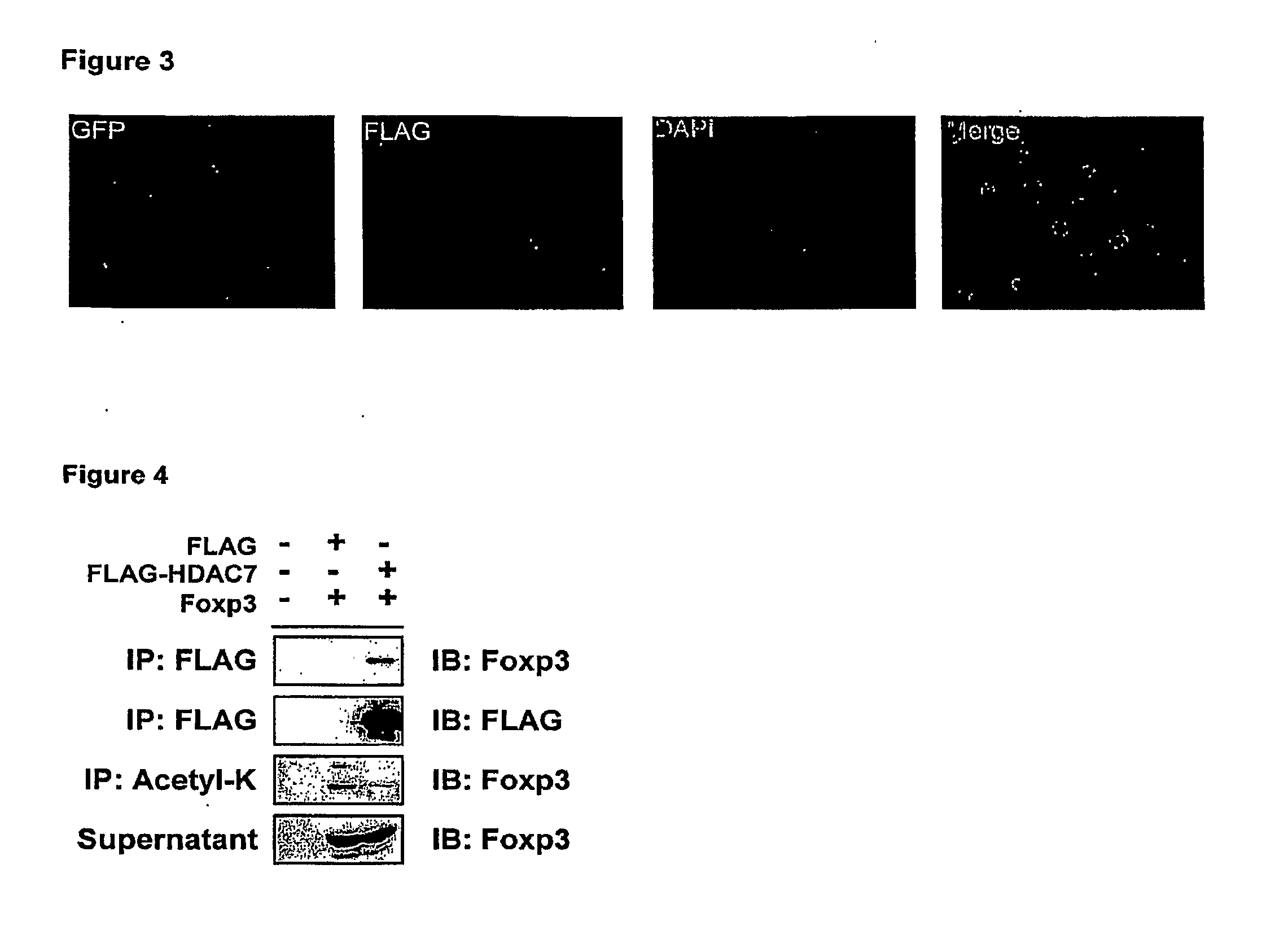Compositions and methods for modulation of suppressor t cell activation
a technology of suppressor t cells and modulation methods, which is applied in the direction of drug compositions, cardiovascular disorders, peptides, etc., can solve the problems of hemizygous male death early after birth, aberrant function, and failure to associate with itself or other members, so as to reduce the risk of rejection of an allograft, reduce the symptom of allergy, and reduce the risk of rejection
- Summary
- Abstract
- Description
- Claims
- Application Information
AI Technical Summary
Benefits of technology
Problems solved by technology
Method used
Image
Examples
example 1
[0107]FOXP3 associates with TIP60 and HDAC7. Our initial studies documented that FOXP3 associated with TIP60. FOXP3 also exists in cytoplasmic and nuclear sites and its expression is linked to the suppressor phenotype in some cells. Because of the complexity of HAT and HDAC ensemble formation we examined interactions of FOXP3 with both Tip 60 and HDAC7. We used 293 T cells which were transfected with expression plasmids for human FOXP3, Flag-tagged TIP60, and Flag tagged HDAC7. The cells were lysed 48 hours later and then subjected to immunoprecipitation with anti-Flag M2 mAb. After transfer, western blots were performed with a variety of antibodies.
[0108]In these preliminary studies using transient expression, we found that both HDAC7 and TIP60 associated with FOXP3. As shown in FIGS. 1(A) and (B), FOXP3 associates with histone acetyltransferase TIP60 and histone deacetylase HDAC7 in vivo. FIG. 1(A) shows HEK 293T cells transfected with expression plasmids for human FOXP3 and, FLAG...
example 2
[0117]Endogenous FOXP3 acetylation in human CD4+CD25+ T cells: To verify whether endogenous FOXP3 is also acetylated under physiological conditions, comparable amounts of nuclear extracts were immunoprecipitated from human FOXP3 expressing CD4+CD25+ regulatory T cells or control Jurkat T cells that lack FOXP3 expression using either monoclonal anti-FOXP3 Ab hFOXY or control IgG, then immunoblotted with rabbit anti-acetyl-lysine polyclonal antibody (Upstate) (FIG. 9, upper panel). After stripping, the immunoblots were reprobed with anti-FOXP3 mAb 221D (FIG. 9, bottom panel). These studies confirmed that endogenous FOXP3 is acetylated in primary human CD4+CD25+ regulatory T cells expanded in vitro.
example 3
[0118]HDAC inhibitor treatment in collagen induced arthritis: HDAC inhibitor VPA was tested in the collagen induced arthritis (CIA) disease model of rheumatoid arthritis. CD4+ T cells as well as B cells are responsible for disease manifestation within the joints and CD25+ Treg play a protective role in disease development. After disease induction with type II collagen, mice were administered VPA (400 mg / kg) or PBS ip daily for 5 weeks. They were scored for severity of disease twice per week. In groups of 10-12 mice, 100% of mice receiving PBS showed signs of disease, whereas only 25% of mice receiving VPA showed any disease at the end of the 5 week study. Additionally, disease severity was greatly reduced in VPA treated mice compared to PBS treated. Splenocytes from collagen induced arthritic mice that were treated with VPA (no disease evident) or PBS (disease evident) were analyzed for expression of CD4, CD25 and FOXP3 by flow cytometry. A 1.63-fold increase in the percentage of FO...
PUM
| Property | Measurement | Unit |
|---|---|---|
| Composition | aaaaa | aaaaa |
| Immunogenicity | aaaaa | aaaaa |
| Antigenicity | aaaaa | aaaaa |
Abstract
Description
Claims
Application Information
 Login to View More
Login to View More - R&D
- Intellectual Property
- Life Sciences
- Materials
- Tech Scout
- Unparalleled Data Quality
- Higher Quality Content
- 60% Fewer Hallucinations
Browse by: Latest US Patents, China's latest patents, Technical Efficacy Thesaurus, Application Domain, Technology Topic, Popular Technical Reports.
© 2025 PatSnap. All rights reserved.Legal|Privacy policy|Modern Slavery Act Transparency Statement|Sitemap|About US| Contact US: help@patsnap.com



